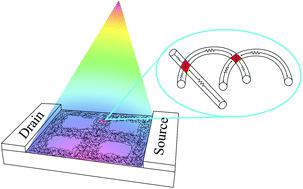Our official English website, www.x-mol.net, welcomes your
feedback! (Note: you will need to create a separate account there.)
Tuning the electro-optical properties of nanowire networks
Nanoscale ( IF 5.8 ) Pub Date : 2021-09-02 , DOI: 10.1039/d1nr03944j Koorosh Esteki 1 , Hugh G Manning 2, 3 , Emmet Sheerin 2, 3 , Mauro S Ferreira 3, 4 , John J Boland 2, 3 , Claudia Gomes da Rocha 1, 5
Nanoscale ( IF 5.8 ) Pub Date : 2021-09-02 , DOI: 10.1039/d1nr03944j Koorosh Esteki 1 , Hugh G Manning 2, 3 , Emmet Sheerin 2, 3 , Mauro S Ferreira 3, 4 , John J Boland 2, 3 , Claudia Gomes da Rocha 1, 5
Affiliation

|
Conductive and transparent metallic nanowire networks are regarded as promising alternatives to Indium–Tin–Oxides (ITOs) in emerging flexible next-generation technologies due to their prominent optoelectronic properties and low-cost fabrication. The performance of such systems closely relies on many geometrical, physical, and intrinsic properties of the nanowire materials as well as the device-layout. A comprehensive computational study is essential to model and quantify the device's optical and electrical responses prior to fabrication. Here, we present a computational toolkit that exploits the electro-optical specifications of distinct device-layouts, namely standard random nanowire network and transparent mesh pattern structures. The target materials for transparent conducting electrodes of this study are aluminium, gold, copper, and silver nanowires. We have examined a variety of tunable parameters including network area fraction, length to diameter aspect ratio, and nanowires angular orientations under different device designs. Moreover, the optical extinction efficiency factors of each material are estimated by two approaches: Mie light scattering theory and finite element method (FEM) algorithm implemented in COMSOL®Multiphysics software. We studied various nanowire network structures and calculated their respective figures of merit (optical transmittance versus sheet resistance) from which insights on the design of next-generation transparent conductor devices can be inferred.
中文翻译:

调整纳米线网络的光电特性
导电和透明的金属纳米线网络由于其突出的光电特性和低成本制造,被认为是新兴灵活的下一代技术中铟锡氧化物 (ITO) 的有前途的替代品。这种系统的性能密切依赖于纳米线材料的许多几何、物理和固有特性以及器件布局。全面的计算研究对于在制造之前对器件的光学和电响应进行建模和量化至关重要。在这里,我们提出了一个计算工具包,它利用不同设备布局的电光规格,即标准随机纳米线网络和透明网格图案结构。本研究透明导电电极的靶材为铝、金、铜、和银纳米线。我们已经研究了各种可调参数,包括网络面积分数、长度与直径的纵横比以及不同设备设计下的纳米线角度方向。此外,每种材料的消光效率因子通过两种方法估算:Mie 光散射理论和在 COMSOL®Multiphysics 软件中实现的有限元法 (FEM) 算法。我们研究了各种纳米线网络结构并计算了它们各自的品质因数(光学透射率 在 COMSOL®Multiphysics 软件中实现的 Mie 光散射理论和有限元法 (FEM) 算法。我们研究了各种纳米线网络结构并计算了它们各自的品质因数(光学透射率 在 COMSOL®Multiphysics 软件中实现的 Mie 光散射理论和有限元法 (FEM) 算法。我们研究了各种纳米线网络结构并计算了它们各自的品质因数(光学透射率与薄层电阻),从中可以推断出对下一代透明导体器件设计的见解。
更新日期:2021-09-09
中文翻译:

调整纳米线网络的光电特性
导电和透明的金属纳米线网络由于其突出的光电特性和低成本制造,被认为是新兴灵活的下一代技术中铟锡氧化物 (ITO) 的有前途的替代品。这种系统的性能密切依赖于纳米线材料的许多几何、物理和固有特性以及器件布局。全面的计算研究对于在制造之前对器件的光学和电响应进行建模和量化至关重要。在这里,我们提出了一个计算工具包,它利用不同设备布局的电光规格,即标准随机纳米线网络和透明网格图案结构。本研究透明导电电极的靶材为铝、金、铜、和银纳米线。我们已经研究了各种可调参数,包括网络面积分数、长度与直径的纵横比以及不同设备设计下的纳米线角度方向。此外,每种材料的消光效率因子通过两种方法估算:Mie 光散射理论和在 COMSOL®Multiphysics 软件中实现的有限元法 (FEM) 算法。我们研究了各种纳米线网络结构并计算了它们各自的品质因数(光学透射率 在 COMSOL®Multiphysics 软件中实现的 Mie 光散射理论和有限元法 (FEM) 算法。我们研究了各种纳米线网络结构并计算了它们各自的品质因数(光学透射率 在 COMSOL®Multiphysics 软件中实现的 Mie 光散射理论和有限元法 (FEM) 算法。我们研究了各种纳米线网络结构并计算了它们各自的品质因数(光学透射率与薄层电阻),从中可以推断出对下一代透明导体器件设计的见解。











































 京公网安备 11010802027423号
京公网安备 11010802027423号